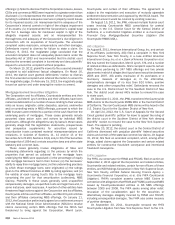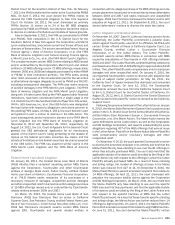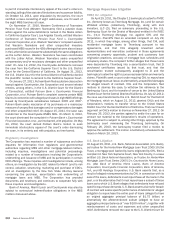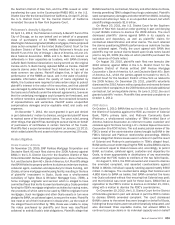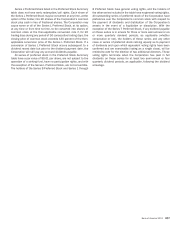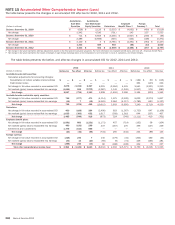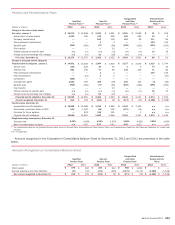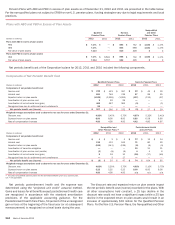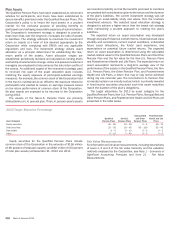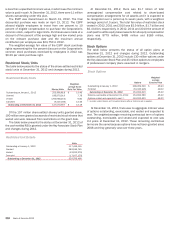Bank of America 2012 Annual Report Download - page 242
Download and view the complete annual report
Please find page 242 of the 2012 Bank of America annual report below. You can navigate through the pages in the report by either clicking on the pages listed below, or by using the keyword search tool below to find specific information within the annual report.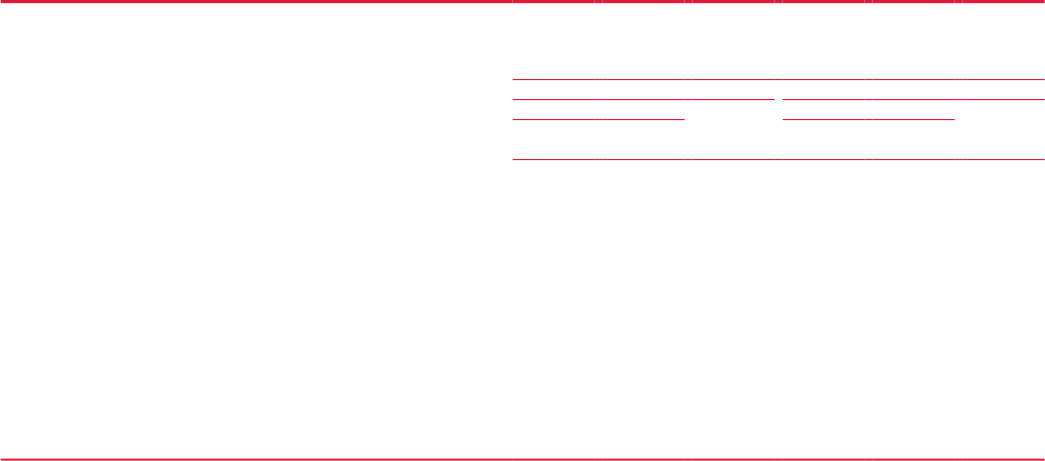
240 Bank of America 2012
Tier 3 capital. Total capital for the Corporation is Tier 1 capital plus
supplementary Tier 2 capital.
To meet minimum, adequately capitalized regulatory
requirements, an institution must maintain a Tier 1 capital ratio
of four percent and a Total capital ratio of eight percent. A “well-
capitalized” institution must generally maintain capital ratios
200 bps higher than the minimum guidelines. The risk-based
capital rules have been further supplemented by a Tier 1 leverage
ratio, defined as Tier 1 capital divided by quarterly average total
assets, after certain adjustments. BHCs must have a minimum
Tier 1 leverage ratio of at least four percent. National banks must
maintain a Tier 1 leverage ratio of at least five percent to be
classified as “well-capitalized.” Failure to meet the capital
requirements established by the joint agencies can lead to certain
mandatory and discretionary actions by regulators that could have
a material adverse effect on the Corporation’s financial position.
At December 31, 2012, the Corporation’s Tier 1 capital, Total
capital and Tier 1 leverage ratios were 12.89 percent, 16.31
percent and 7.37 percent, respectively.
Current guidelines restrict certain core capital elements to 15
percent of total core capital elements for internationally active
BHCs. Internationally active BHCs are those that have significant
activities in non-U.S. markets with consolidated assets greater
than $250 billion or on-balance sheet non-U.S. exposure greater
than $10 billion, which includes the Corporation. In addition, the
Federal Reserve revised the qualitative standards for capital
instruments included in regulatory capital. At December 31, 2012,
the Corporation’s restricted core capital elements comprised 3.6
percent of total core capital elements. The Corporation is and
expects to remain in compliance with the revised guidelines.
Tier 1 common capital is not an official regulatory ratio, but was
introduced by the Federal Reserve during the Supervisory Capital
Assessment Program in 2009. Tier 1 common capital is Tier 1
capital less preferred stock, Trust Securities, hybrid securities and
qualifying noncontrolling interests in subsidiaries. The
Corporation’s Tier 1 common capital was $133.4 billion and
$126.7 billion and the Tier 1 common capital ratio was 11.06
percent and 9.86 percent at December 31, 2012 and 2011.
The table below presents actual and minimum required
regulatory capital amounts for 2012 and 2011.
Regulatory Capital
December 31
2012 2011
Actual Actual
(Dollars in millions) Ratio Amount
Minimum
Required (1) Ratio Amount
Minimum
Required (1)
Risk-based capital
Tier 1 common
Bank of America Corporation 11.06% $ 133,403 n/a 9.86% $ 126,690 n/a
Tier 1
Bank of America Corporation 12.89 155,461 $ 72,359 12.40 159,232 $ 77,068
Bank of America, N.A. 12.44 118,431 57,099 11.74 119,881 61,245
FIA Card Services, N.A. 17.34 22,061 7,632 17.63 24,660 8,393
Total
Bank of America Corporation 16.31 196,680 120,598 16.75 215,101 128,447
Bank of America, N.A. 14.76 140,434 95,165 15.17 154,885 102,076
FIA Card Services, N.A. 18.64 23,707 12,719 19.01 26,594 13,989
Tier 1 leverage
Bank of America Corporation 7.37 155,461 84,429 7.53 159,232 84,557
Bank of America, N.A. 8.59 118,431 68,957 8.65 119,881 69,318
FIA Card Services, N.A. 13.67 22,061 8,067 14.22 24,660 8,669
(1) Dollar amount required to meet guidelines for well-capitalized institutions.
n/a = not applicable
The Federal Reserve requires BHCs to submit a capital plan
and requests for capital actions on an annual basis, consistent
with the rules governing the Comprehensive Capital Analysis and
Review (CCAR). The CCAR is the central element of the Federal
Reserve’s approach to ensuring large BHCs have adequate capital
and robust processes for managing their capital. Requests for
capital actions by a BHC must be reviewed on an annual basis by
the Federal Reserve. In January 2012, the Corporation submitted
its 2012 capital plan and the Federal Reserve did not object to
the Corporation’s 2012 capital plan. On January 7, 2013, the
Corporation submitted its 2013 capital plan and related
supervisory stress tests. The Federal Reserve has announced its
intention to notify the 2013 CCAR participants of the supervisory
stress test results on March 7, 2013 and the capital plan on March
14, 2013.
Regulatory Capital Developments
At December 31, 2012, the Corporation measured and reported
its capital ratios and related information in accordance with Basel
1 and the regulatory capital rules continue to expand and evolve.
In June 2012, U.S. banking regulators issued the Market Risk Final
Rule that amends the Basel 1 Market Risk rules (Market Risk Final
Rule) which were effective January 1, 2013. The Market Risk Final
Rule introduces new measures of market risk, a stressed Value-
at-Risk charge, an incremental risk charge and a comprehensive
risk measure, as well as other technical modifications.
In December 2007, U.S. banking regulators published final
Basel 2 rules (Basel 2). Basel 2 provides detailed requirements
for a new regulatory capital framework related to credit and
operational risk, supervisory requirements and disclosure
requirements. Under Basel 2, market risk is measured consistent
with Basel 1 guidelines, in accordance with the Market Risk Final


